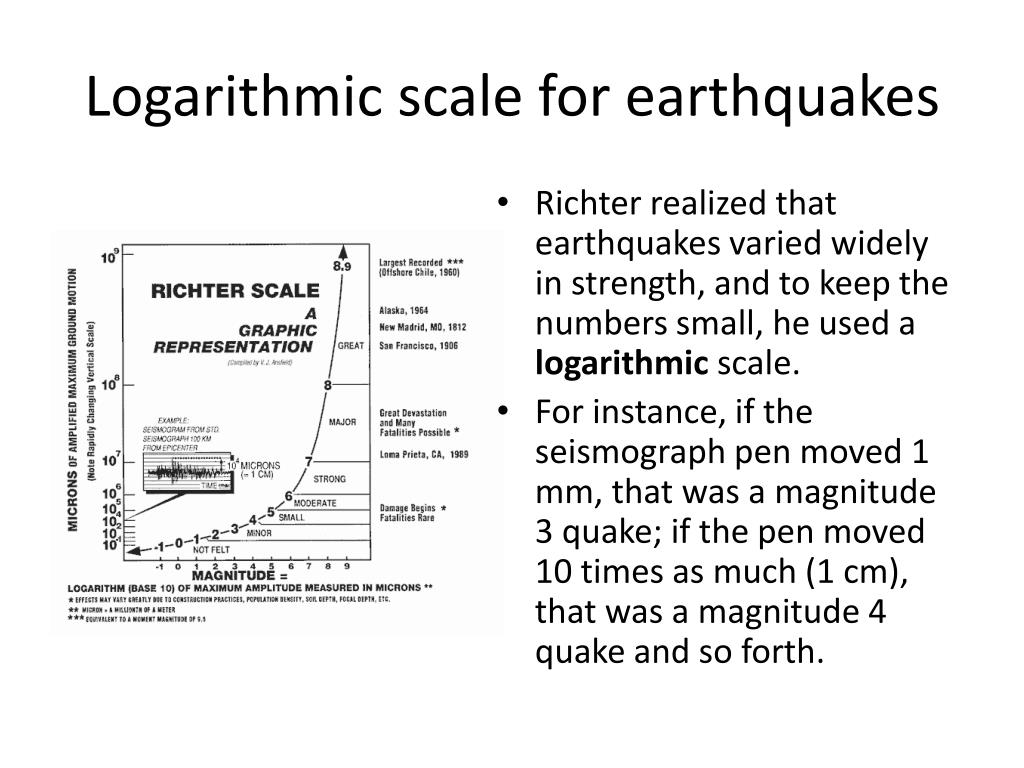Logarithmic Scale Earthquake Magnitude | An increase in one integer means that 30 times more energy was released, while two. A logarithmic scale (or log scale) is a way of displaying numerical data over a very wide range of values in a compact way—typically the largest numbers in the data are hundreds or even thousands of times larger than the smallest numbers. That just means that if you add 1 to an earthquake's magnitude, you multiply the shaking by 10. This method measures the total energy released by like the richter scale, the moment magnitude scale is logarithmic. The richter scale and the moment magnitude scale are logarithmic.
Download and use 50+ earthquake magnitude logarithmic scale stock videos for free. I've been doing a bunch of videos about logarithmic scale and we've also unfortunately had many notable earthquakes this year so i thought i measure earthquakes now the one that we actually use now is the moment magnitude scale and the reason why most people don't make a huge. The richter scale is logarithmic. How is earthquake magnitude measured? Earthquakes of magnitude 8.5 or greater generally occur on a type of fault (crack in the earth's crust) called a subduction zone.
The richter scale and the moment magnitude scale are logarithmic. The richter scale measures the magnitude of an earthquake (how powerful it is). 30,000 5.5 to 6.0 slight damage to buildings and other structures. Magnitude 6 quake 10 * magnitude 5 energy: Measuring earthquakes more on logarithmic scales and human perception how intense is an earthquake? If an amplitude of 20 millimetres as measured on a seismic signal corresponds to a magnitude 2 earthquake, then: Earthquakes are also classified in categories ranging from minor to great, depending on their magnitude. What does this have to do with. The magnitude scale is logarithmic, so a magnitude 9.7 earthquake is $\frac{10^{9.7}}{10^{6.8}} = 794.328$ times bigger on the seismogram than a magnitude 6.8 earthquake. The richter scale is logarithmic, meaning it goes up by levels of ten, so a magnitude 10 earthquake is 10 times larger than a magnitude 9. Earthquake magnitude is a measure of the size, or amplitude, of the seismic waves generated by as defined, an earthquake magnitude scale has no lower or upper limit. New and ugly things happen. The severity of an earthquake can be expressed in terms of both intensity and magnitude.
An earthquake has one magnitude unit. The richter magnitude of an earthquake is determined from the logarithm of the amplitude of waves recorded by seismographs. The amplitude of the largest wave increases ten times from one integer to the next. 10 times less (2 millimetres) corresponds to a magnitude of 1; That just means that if you add 1 to an earthquake's magnitude, you multiply the shaking by 10.

The amplitude of the largest wave increases ten times from one integer to the next. 30,000 5.5 to 6.0 slight damage to buildings and other structures. The severity of an earthquake can be expressed in terms of both intensity and magnitude. This method measures the total energy released by like the richter scale, the moment magnitude scale is logarithmic. Logarithmic measure of earthquake size amplitude of biggest wave: What does this have to do with. The magnitude does not depend on the location where measurement is made. It is logarithmic which means, for example, that an earthquake measuring magnitude 5 is ten times more powerful than an earthquake measuring 4. An important piece of information to keep in mind is that the magnitude scale is logarithmic. Magnitude 6 quake 10 * magnitude 5 energy: Sensitive seismographs can record earthquakes with magnitudes of. The richter scale is logarithmic, meaning it goes up by levels of ten, so a magnitude 10 earthquake is 10 times larger than a magnitude 9. The scale would have to be logarithmic;
The richter magnitude of an earthquake is determined from the logarithm of the amplitude of waves recorded by seismographs. What does this have to do with. The richter scale is logarithmic. The richter scale measures the magnitude of an earthquake (how powerful it is). A logarithmic scale (or log scale) is a way of displaying numerical data over a very wide range of values in a compact way—typically the largest numbers in the data are hundreds or even thousands of times larger than the smallest numbers.

That just means that if you add 1 to an earthquake's magnitude, you multiply the shaking by 10. An increase in one integer means that 30 times more energy was released, while two. What does this have to do with. It measures the total energy released by an. The magnitude scale is logarithmic, so a magnitude 9.7 earthquake is $\frac{10^{9.7}}{10^{6.8}} = 794.328$ times bigger on the seismogram than a magnitude 6.8 earthquake. Richter chose log to the base 10. The height of the largest wave increases 10 times with each level. Measuring earthquakes more on logarithmic scales and human perception how intense is an earthquake? If an amplitude of 20 millimetres as measured on a seismic signal corresponds to a magnitude 2 earthquake, then: The united states geological survey (usgs) measured the earthquake at 7.8 magnitude, whereas akshat rathi and david yanofsky for quartz explain in a lesson of the logarithmic scale and earthquake magnitude. Sensitive seismographs can record earthquakes with magnitudes of. An important piece of information to keep in mind is that the magnitude scale is logarithmic. Magnitude scales are logarithmic, so an increase in one unit e.g.
Calculator for the comparison of two earthquake magnitudes given in the richter scale earthquake scale magnitude. The magnitude scale is logarithmic, so a magnitude 9.7 earthquake is $\frac{10^{9.7}}{10^{6.8}} = 794.328$ times bigger on the seismogram than a magnitude 6.8 earthquake.
Logarithmic Scale Earthquake Magnitude: New and ugly things happen.
0 comments:
Post a Comment